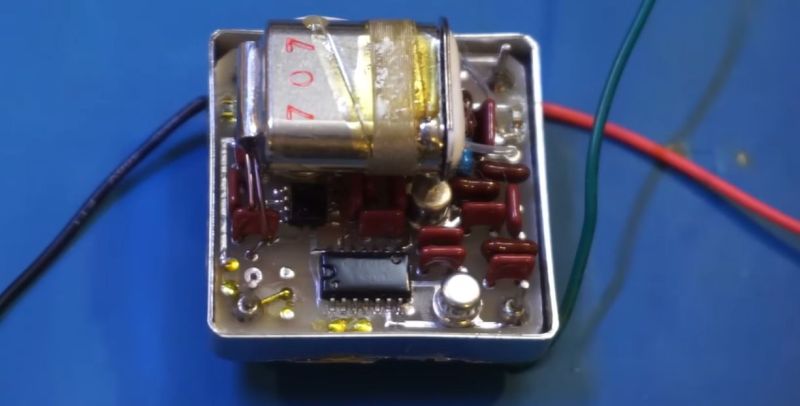Crystal oscillators are incredibly useful components, but they come with one little snag: their oscillation is temperature-dependent. For many applications the relatively small deviation is not a problem, but especially for precision instruments this is a deal breaker. Enter the oven controlled crystal oscillator, or OCXO. These do basically what it says on the tin, but what’s inside them? [Kerry Wong] took apart a vintage Toyocom TCO-627VC 10 MHz OCXO, revealing a lot more complexity than one might assume.
Inside the insulated enclosure there is of course the crystal oscillator itself, which has a heating coil wrapped around it. Of note is that other OCXOs that [Kerry] took apart had more insulation, as well as other ways of providing the thermal energy. In this particular unit a thermistor is attached to the crystal’s metal case to measure its temperature and provide feedback to the heating circuit. The ICs on the PCB are hard to identify due to the conformal coating, but at least one appears to be a 74LS00, alongside a 78L05 voltage regulator which reduces the 12V input voltage.
As an older OCXO it probably is a lot chunkier than newer units, but the basic principle remains the same, with a heating loop that ensures that the crystal inside the unit remains at the same temperature.
















Wonderful teardown. I love seeing older electronics disassembled and analyzed.
Story Time: My first job out of college we had a problem where a microcontroller in our prototype RF switch would start having problems around -70C. The oscillator was good enough above that. My manager gave me a day to come up with a solution.
My solution was a 100 Ohm resistor connected to 5v and a spare Darlington in an array already on the PCB, with the resistor mounted directly on top of the MCU and a bit of ceramic wool taped on top.
It worked! Manager was not impressed and killed the idea on the basis that customers wouldn’t like the look of it either.
Not being sarcastic, but I’d hate to see all those customers in the Artic circle lost!
Don’t leave us hanging, did you sell it to people in cryolabs? Why -70°Centigrade? This is a lot! Or I am a dummy myself. Might be some industrial “spec” that your company must comply with, even if it makes no sense. Wait I got it, the RF was used in airplanes, right?
Aerospace presumably?
The solution seems reasonable, presentation possibly not.
Aerospace.
Specifically, every other product the company sold was rated down to -70C. The concern was mostly explaining to customers why this product was different.
The good news is nobody actually needed a waveguide switch at space temperatures with an Ethernet interface.
What did he expected for a “1 day solution”? By the way, what solution did you finally implement?
Final solution was to tell customers that a special, more expensive low-temperature variant would be available upon request. Don’t need to fix a problem if you can convince the customer it is a cost-saving measure.
For a one day solution that wasn’t bad, I think.
Quick fixes are seldomly “pretty”, after all.
I mean, sure, a peltier element w/ adhesive strips and a heatsink would look more professional.
But who has such stuff casually lying around in the cup board!?
On solution would be for the MCU to drive a few resistors from the gpio pins if its temperature drops. If the resistors are close enough and thermally coupled to the MCU this will heat up the MCU. Perhaps enabling some power hungry peripherals or increasing the clock frequency can also be used for more minor cold temperatures. This only works if the MCU has an internal temperature sensor. But an MCU can regulate its own temperature this way!